Recording Business Transactions: Assessment 1, BA3LC92O, LSST
VerifiedAdded on 2023/01/05
|8
|1624
|99
Homework Assignment
AI Summary
This document presents a solution to an assignment on recording business transactions, focusing on key aspects of financial accounting. The assignment begins with the identification of decision-makers within a business context and explores the advantages and disadvantages of various profit business structures. Part 2 provides detailed journal entries for the month of February, illustrating the recording of various transactions. Part 3 includes a trial balance as of February 30, 2019, which summarizes the debit and credit balances of different accounts. Part 4 focuses on the preparation of an income statement for the year ending September 30, 2020, and analyzes the potential impact of the COVID-19 pandemic on the company's financial statement items, considering factors such as income, expenses, and the challenges in accurately determining the pandemic's effects on financial reporting. This assignment provides a comprehensive overview of accounting principles and their application in practical scenarios.
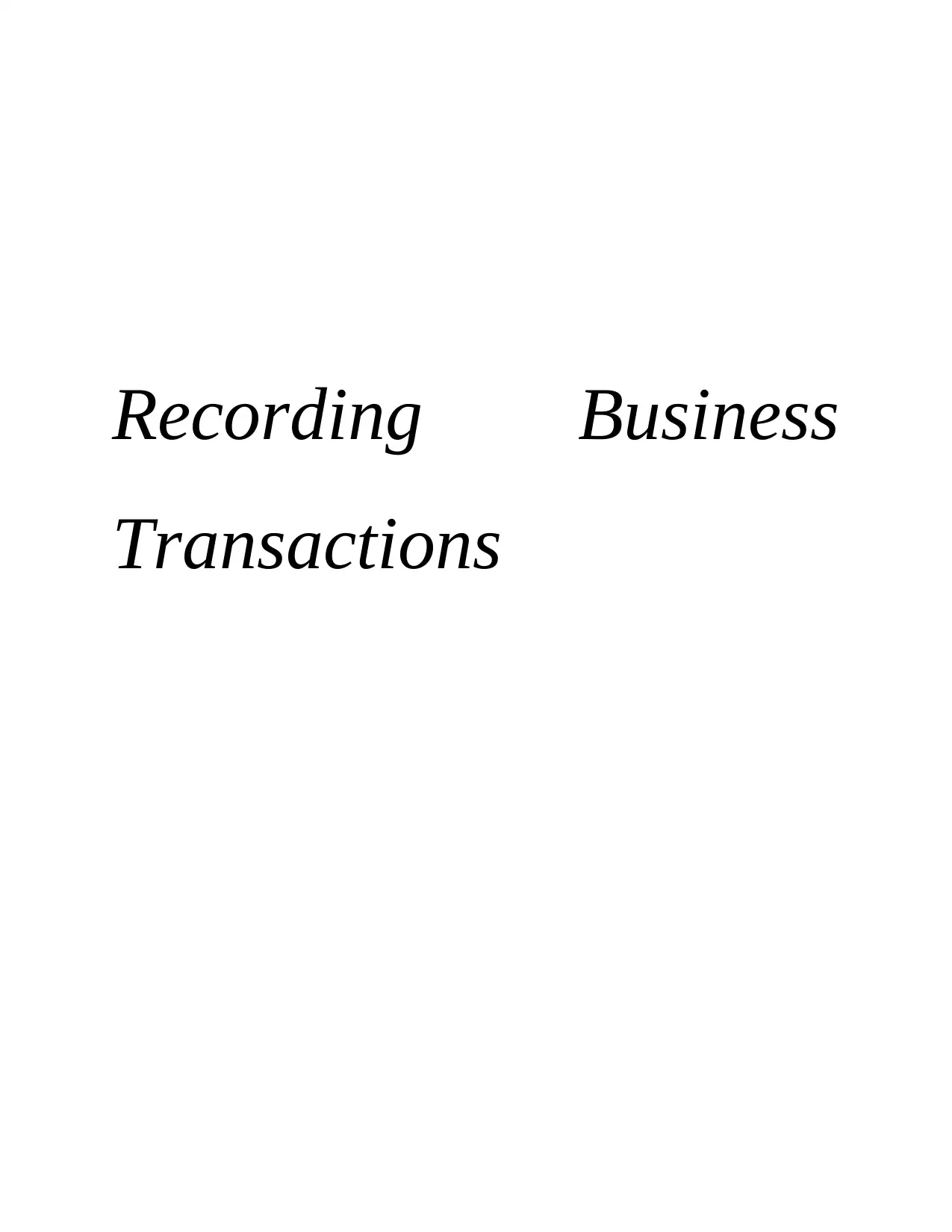
Recording Business
Transactions
Transactions
Paraphrase This Document
Need a fresh take? Get an instant paraphrase of this document with our AI Paraphraser
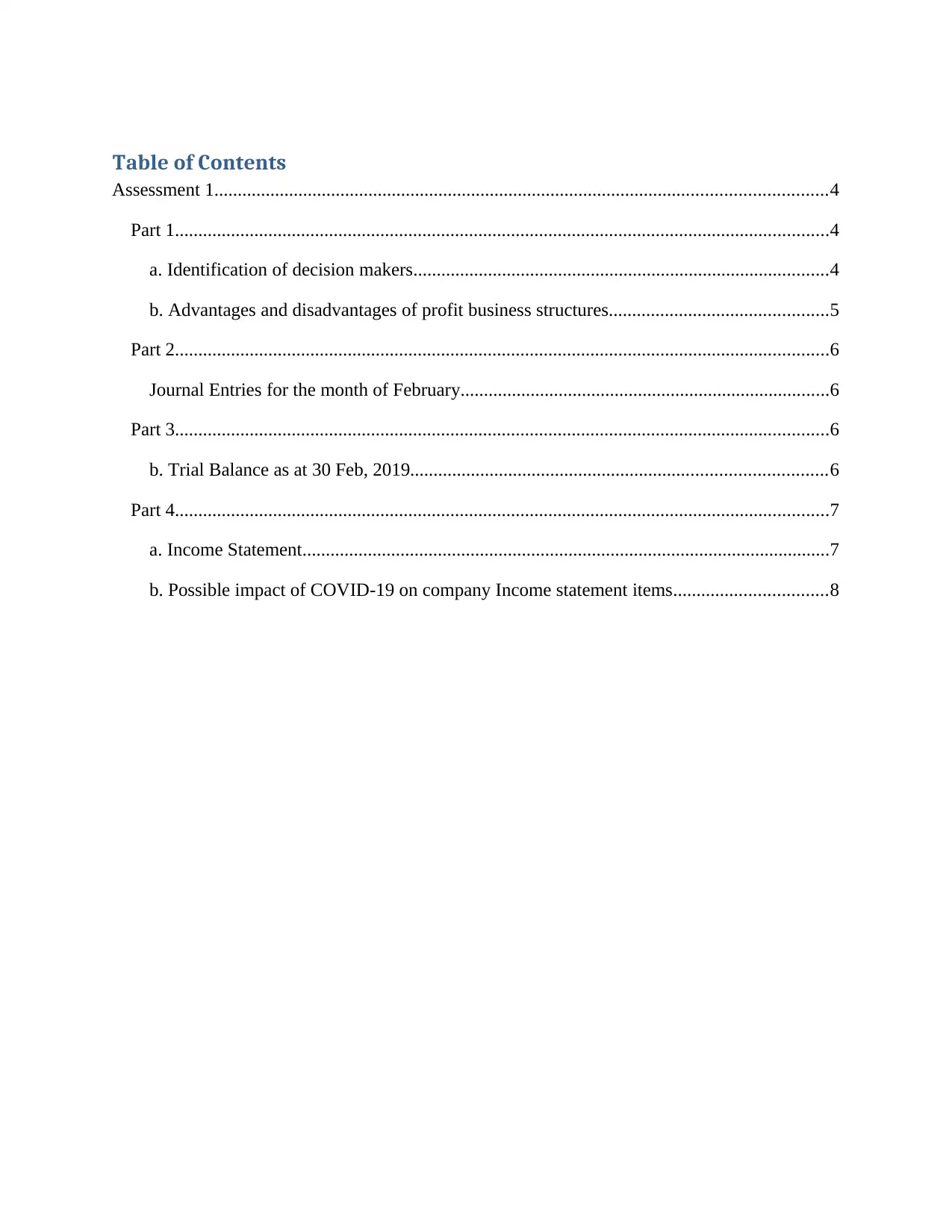
Table of Contents
Assessment 1...................................................................................................................................4
Part 1............................................................................................................................................4
a. Identification of decision makers.........................................................................................4
b. Advantages and disadvantages of profit business structures...............................................5
Part 2............................................................................................................................................6
Journal Entries for the month of February...............................................................................6
Part 3............................................................................................................................................6
b. Trial Balance as at 30 Feb, 2019.........................................................................................6
Part 4............................................................................................................................................7
a. Income Statement.................................................................................................................7
b. Possible impact of COVID-19 on company Income statement items.................................8
Assessment 1...................................................................................................................................4
Part 1............................................................................................................................................4
a. Identification of decision makers.........................................................................................4
b. Advantages and disadvantages of profit business structures...............................................5
Part 2............................................................................................................................................6
Journal Entries for the month of February...............................................................................6
Part 3............................................................................................................................................6
b. Trial Balance as at 30 Feb, 2019.........................................................................................6
Part 4............................................................................................................................................7
a. Income Statement.................................................................................................................7
b. Possible impact of COVID-19 on company Income statement items.................................8
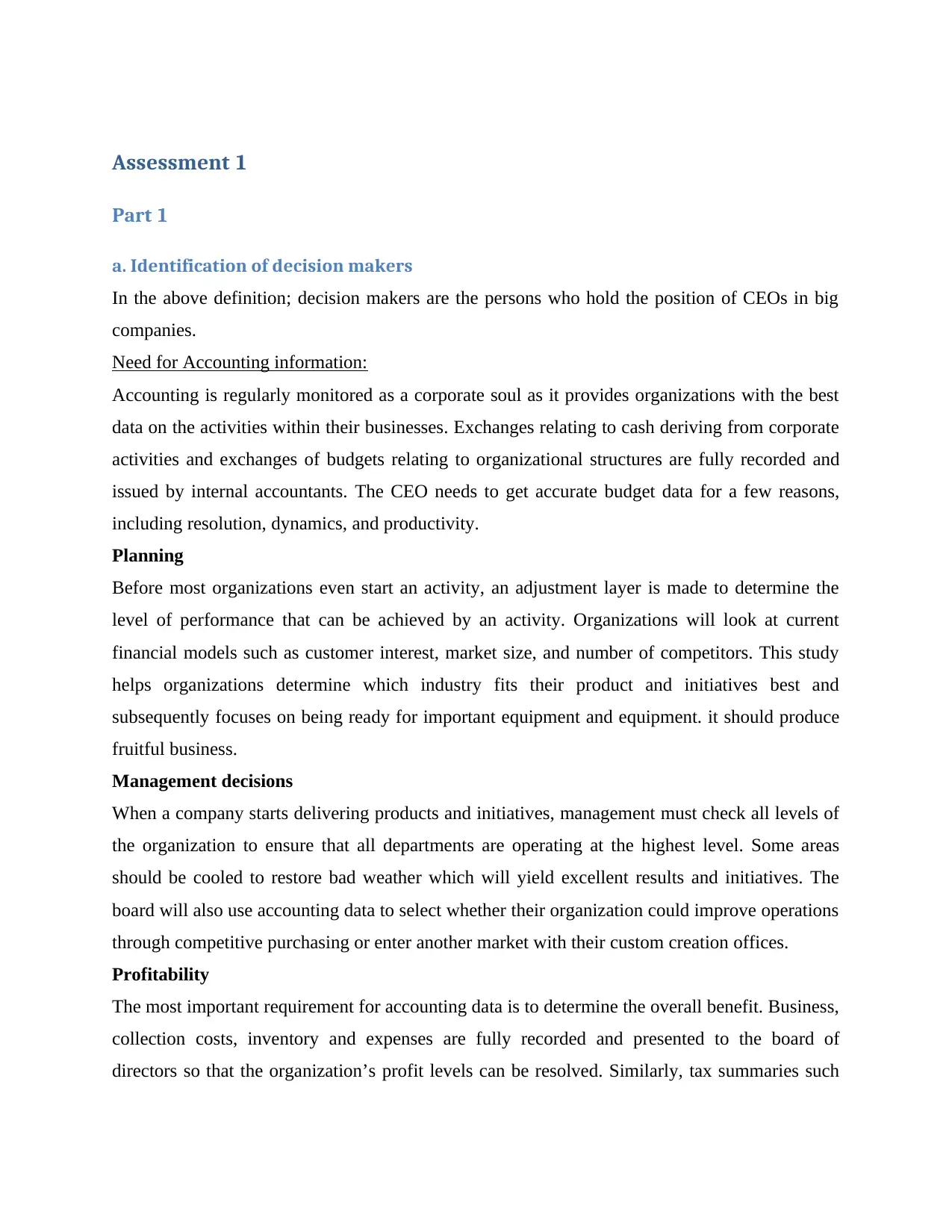
Assessment 1
Part 1
a. Identification of decision makers
In the above definition; decision makers are the persons who hold the position of CEOs in big
companies.
Need for Accounting information:
Accounting is regularly monitored as a corporate soul as it provides organizations with the best
data on the activities within their businesses. Exchanges relating to cash deriving from corporate
activities and exchanges of budgets relating to organizational structures are fully recorded and
issued by internal accountants. The CEO needs to get accurate budget data for a few reasons,
including resolution, dynamics, and productivity.
Planning
Before most organizations even start an activity, an adjustment layer is made to determine the
level of performance that can be achieved by an activity. Organizations will look at current
financial models such as customer interest, market size, and number of competitors. This study
helps organizations determine which industry fits their product and initiatives best and
subsequently focuses on being ready for important equipment and equipment. it should produce
fruitful business.
Management decisions
When a company starts delivering products and initiatives, management must check all levels of
the organization to ensure that all departments are operating at the highest level. Some areas
should be cooled to restore bad weather which will yield excellent results and initiatives. The
board will also use accounting data to select whether their organization could improve operations
through competitive purchasing or enter another market with their custom creation offices.
Profitability
The most important requirement for accounting data is to determine the overall benefit. Business,
collection costs, inventory and expenses are fully recorded and presented to the board of
directors so that the organization’s profit levels can be resolved. Similarly, tax summaries such
Part 1
a. Identification of decision makers
In the above definition; decision makers are the persons who hold the position of CEOs in big
companies.
Need for Accounting information:
Accounting is regularly monitored as a corporate soul as it provides organizations with the best
data on the activities within their businesses. Exchanges relating to cash deriving from corporate
activities and exchanges of budgets relating to organizational structures are fully recorded and
issued by internal accountants. The CEO needs to get accurate budget data for a few reasons,
including resolution, dynamics, and productivity.
Planning
Before most organizations even start an activity, an adjustment layer is made to determine the
level of performance that can be achieved by an activity. Organizations will look at current
financial models such as customer interest, market size, and number of competitors. This study
helps organizations determine which industry fits their product and initiatives best and
subsequently focuses on being ready for important equipment and equipment. it should produce
fruitful business.
Management decisions
When a company starts delivering products and initiatives, management must check all levels of
the organization to ensure that all departments are operating at the highest level. Some areas
should be cooled to restore bad weather which will yield excellent results and initiatives. The
board will also use accounting data to select whether their organization could improve operations
through competitive purchasing or enter another market with their custom creation offices.
Profitability
The most important requirement for accounting data is to determine the overall benefit. Business,
collection costs, inventory and expenses are fully recorded and presented to the board of
directors so that the organization’s profit levels can be resolved. Similarly, tax summaries such
⊘ This is a preview!⊘
Do you want full access?
Subscribe today to unlock all pages.

Trusted by 1+ million students worldwide
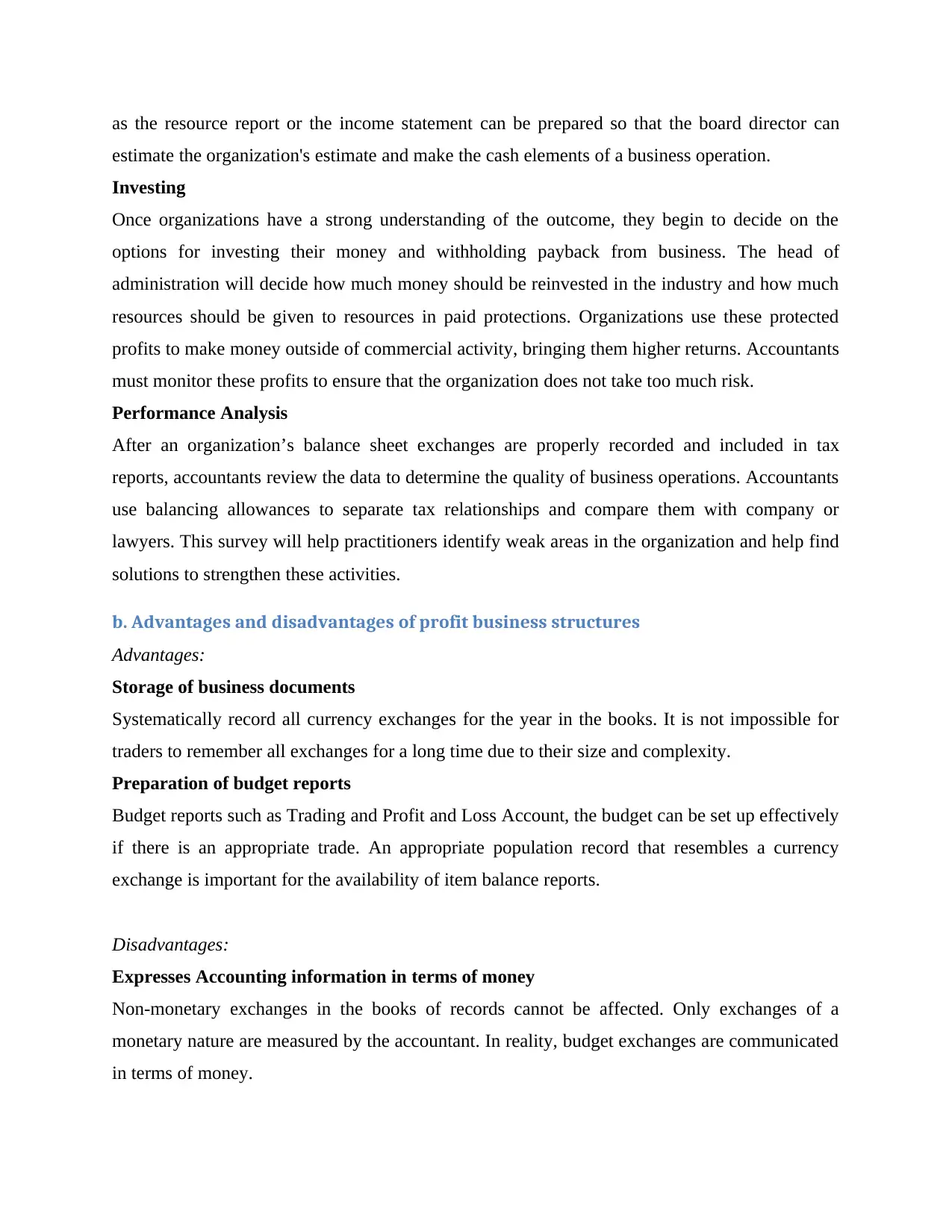
as the resource report or the income statement can be prepared so that the board director can
estimate the organization's estimate and make the cash elements of a business operation.
Investing
Once organizations have a strong understanding of the outcome, they begin to decide on the
options for investing their money and withholding payback from business. The head of
administration will decide how much money should be reinvested in the industry and how much
resources should be given to resources in paid protections. Organizations use these protected
profits to make money outside of commercial activity, bringing them higher returns. Accountants
must monitor these profits to ensure that the organization does not take too much risk.
Performance Analysis
After an organization’s balance sheet exchanges are properly recorded and included in tax
reports, accountants review the data to determine the quality of business operations. Accountants
use balancing allowances to separate tax relationships and compare them with company or
lawyers. This survey will help practitioners identify weak areas in the organization and help find
solutions to strengthen these activities.
b. Advantages and disadvantages of profit business structures
Advantages:
Storage of business documents
Systematically record all currency exchanges for the year in the books. It is not impossible for
traders to remember all exchanges for a long time due to their size and complexity.
Preparation of budget reports
Budget reports such as Trading and Profit and Loss Account, the budget can be set up effectively
if there is an appropriate trade. An appropriate population record that resembles a currency
exchange is important for the availability of item balance reports.
Disadvantages:
Expresses Accounting information in terms of money
Non-monetary exchanges in the books of records cannot be affected. Only exchanges of a
monetary nature are measured by the accountant. In reality, budget exchanges are communicated
in terms of money.
estimate the organization's estimate and make the cash elements of a business operation.
Investing
Once organizations have a strong understanding of the outcome, they begin to decide on the
options for investing their money and withholding payback from business. The head of
administration will decide how much money should be reinvested in the industry and how much
resources should be given to resources in paid protections. Organizations use these protected
profits to make money outside of commercial activity, bringing them higher returns. Accountants
must monitor these profits to ensure that the organization does not take too much risk.
Performance Analysis
After an organization’s balance sheet exchanges are properly recorded and included in tax
reports, accountants review the data to determine the quality of business operations. Accountants
use balancing allowances to separate tax relationships and compare them with company or
lawyers. This survey will help practitioners identify weak areas in the organization and help find
solutions to strengthen these activities.
b. Advantages and disadvantages of profit business structures
Advantages:
Storage of business documents
Systematically record all currency exchanges for the year in the books. It is not impossible for
traders to remember all exchanges for a long time due to their size and complexity.
Preparation of budget reports
Budget reports such as Trading and Profit and Loss Account, the budget can be set up effectively
if there is an appropriate trade. An appropriate population record that resembles a currency
exchange is important for the availability of item balance reports.
Disadvantages:
Expresses Accounting information in terms of money
Non-monetary exchanges in the books of records cannot be affected. Only exchanges of a
monetary nature are measured by the accountant. In reality, budget exchanges are communicated
in terms of money.
Paraphrase This Document
Need a fresh take? Get an instant paraphrase of this document with our AI Paraphraser
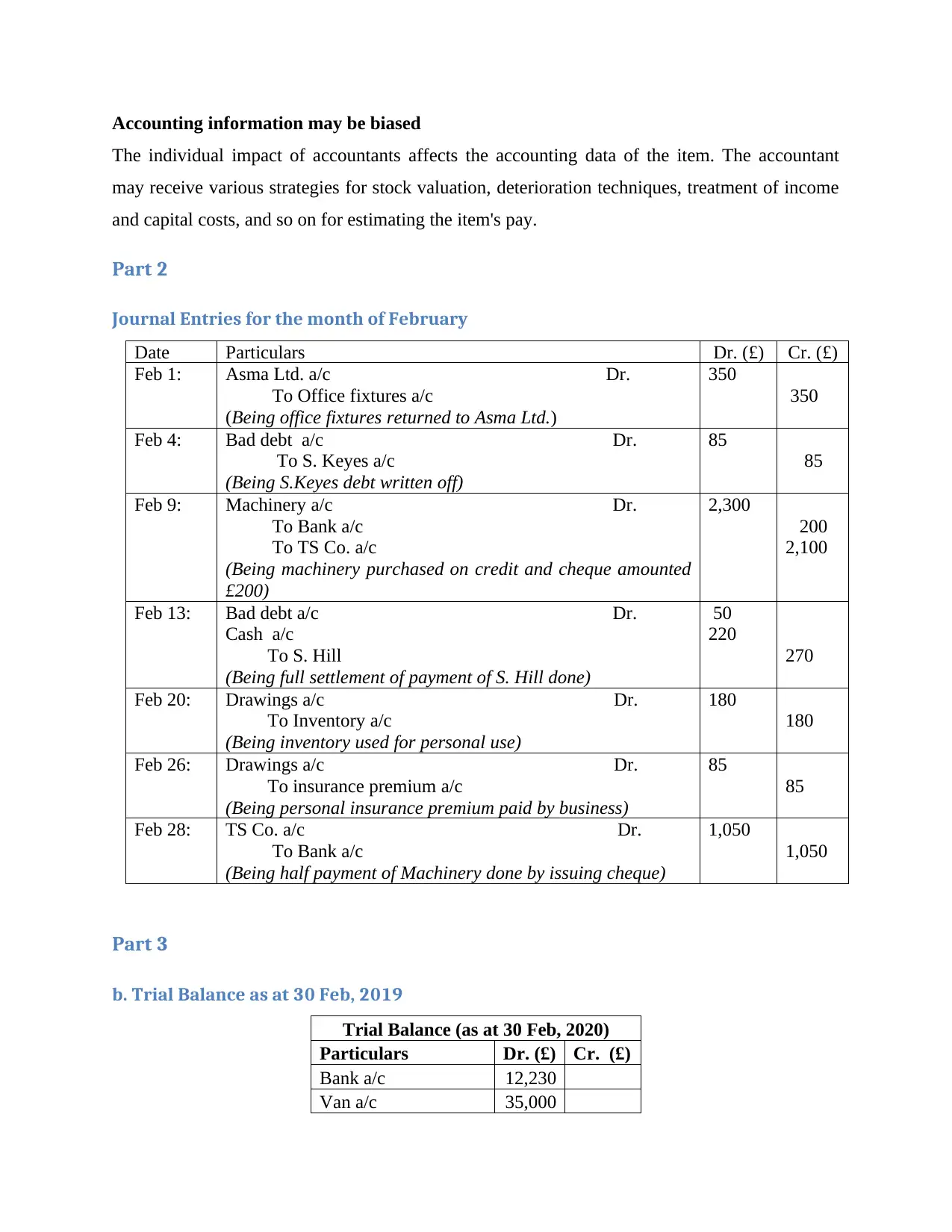
Accounting information may be biased
The individual impact of accountants affects the accounting data of the item. The accountant
may receive various strategies for stock valuation, deterioration techniques, treatment of income
and capital costs, and so on for estimating the item's pay.
Part 2
Journal Entries for the month of February
Date Particulars Dr. (£) Cr. (£)
Feb 1: Asma Ltd. a/c Dr.
To Office fixtures a/c
(Being office fixtures returned to Asma Ltd.)
350
350
Feb 4: Bad debt a/c Dr.
To S. Keyes a/c
(Being S.Keyes debt written off)
85
85
Feb 9: Machinery a/c Dr.
To Bank a/c
To TS Co. a/c
(Being machinery purchased on credit and cheque amounted
£200)
2,300
200
2,100
Feb 13: Bad debt a/c Dr.
Cash a/c
To S. Hill
(Being full settlement of payment of S. Hill done)
50
220
270
Feb 20: Drawings a/c Dr.
To Inventory a/c
(Being inventory used for personal use)
180
180
Feb 26: Drawings a/c Dr.
To insurance premium a/c
(Being personal insurance premium paid by business)
85
85
Feb 28: TS Co. a/c Dr.
To Bank a/c
(Being half payment of Machinery done by issuing cheque)
1,050
1,050
Part 3
b. Trial Balance as at 30 Feb, 2019
Trial Balance (as at 30 Feb, 2020)
Particulars Dr. (£) Cr. (£)
Bank a/c 12,230
Van a/c 35,000
The individual impact of accountants affects the accounting data of the item. The accountant
may receive various strategies for stock valuation, deterioration techniques, treatment of income
and capital costs, and so on for estimating the item's pay.
Part 2
Journal Entries for the month of February
Date Particulars Dr. (£) Cr. (£)
Feb 1: Asma Ltd. a/c Dr.
To Office fixtures a/c
(Being office fixtures returned to Asma Ltd.)
350
350
Feb 4: Bad debt a/c Dr.
To S. Keyes a/c
(Being S.Keyes debt written off)
85
85
Feb 9: Machinery a/c Dr.
To Bank a/c
To TS Co. a/c
(Being machinery purchased on credit and cheque amounted
£200)
2,300
200
2,100
Feb 13: Bad debt a/c Dr.
Cash a/c
To S. Hill
(Being full settlement of payment of S. Hill done)
50
220
270
Feb 20: Drawings a/c Dr.
To Inventory a/c
(Being inventory used for personal use)
180
180
Feb 26: Drawings a/c Dr.
To insurance premium a/c
(Being personal insurance premium paid by business)
85
85
Feb 28: TS Co. a/c Dr.
To Bank a/c
(Being half payment of Machinery done by issuing cheque)
1,050
1,050
Part 3
b. Trial Balance as at 30 Feb, 2019
Trial Balance (as at 30 Feb, 2020)
Particulars Dr. (£) Cr. (£)
Bank a/c 12,230
Van a/c 35,000
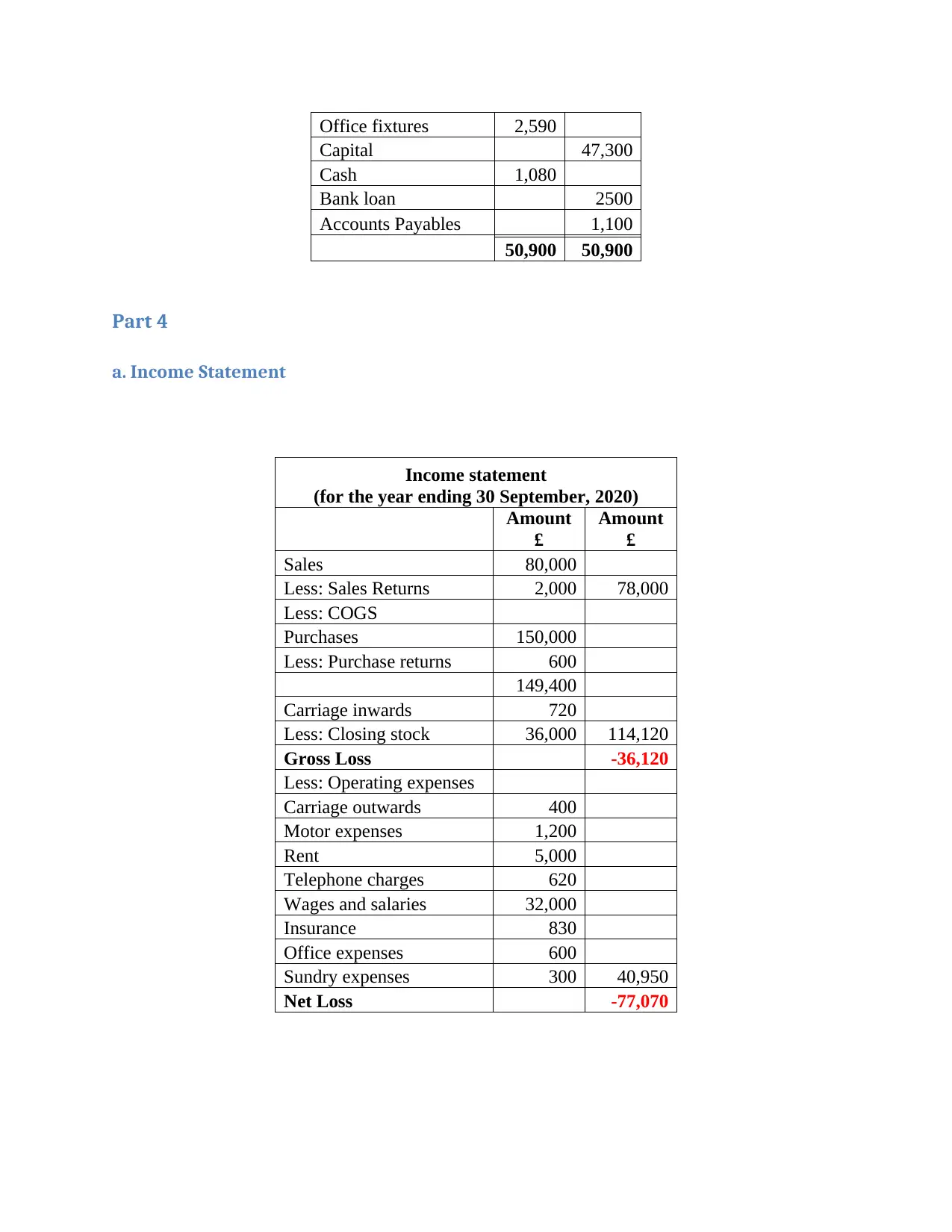
Office fixtures 2,590
Capital 47,300
Cash 1,080
Bank loan 2500
Accounts Payables 1,100
50,900 50,900
Part 4
a. Income Statement
Income statement
(for the year ending 30 September, 2020)
Amount
£
Amount
£
Sales 80,000
Less: Sales Returns 2,000 78,000
Less: COGS
Purchases 150,000
Less: Purchase returns 600
149,400
Carriage inwards 720
Less: Closing stock 36,000 114,120
Gross Loss -36,120
Less: Operating expenses
Carriage outwards 400
Motor expenses 1,200
Rent 5,000
Telephone charges 620
Wages and salaries 32,000
Insurance 830
Office expenses 600
Sundry expenses 300 40,950
Net Loss -77,070
Capital 47,300
Cash 1,080
Bank loan 2500
Accounts Payables 1,100
50,900 50,900
Part 4
a. Income Statement
Income statement
(for the year ending 30 September, 2020)
Amount
£
Amount
£
Sales 80,000
Less: Sales Returns 2,000 78,000
Less: COGS
Purchases 150,000
Less: Purchase returns 600
149,400
Carriage inwards 720
Less: Closing stock 36,000 114,120
Gross Loss -36,120
Less: Operating expenses
Carriage outwards 400
Motor expenses 1,200
Rent 5,000
Telephone charges 620
Wages and salaries 32,000
Insurance 830
Office expenses 600
Sundry expenses 300 40,950
Net Loss -77,070
⊘ This is a preview!⊘
Do you want full access?
Subscribe today to unlock all pages.

Trusted by 1+ million students worldwide
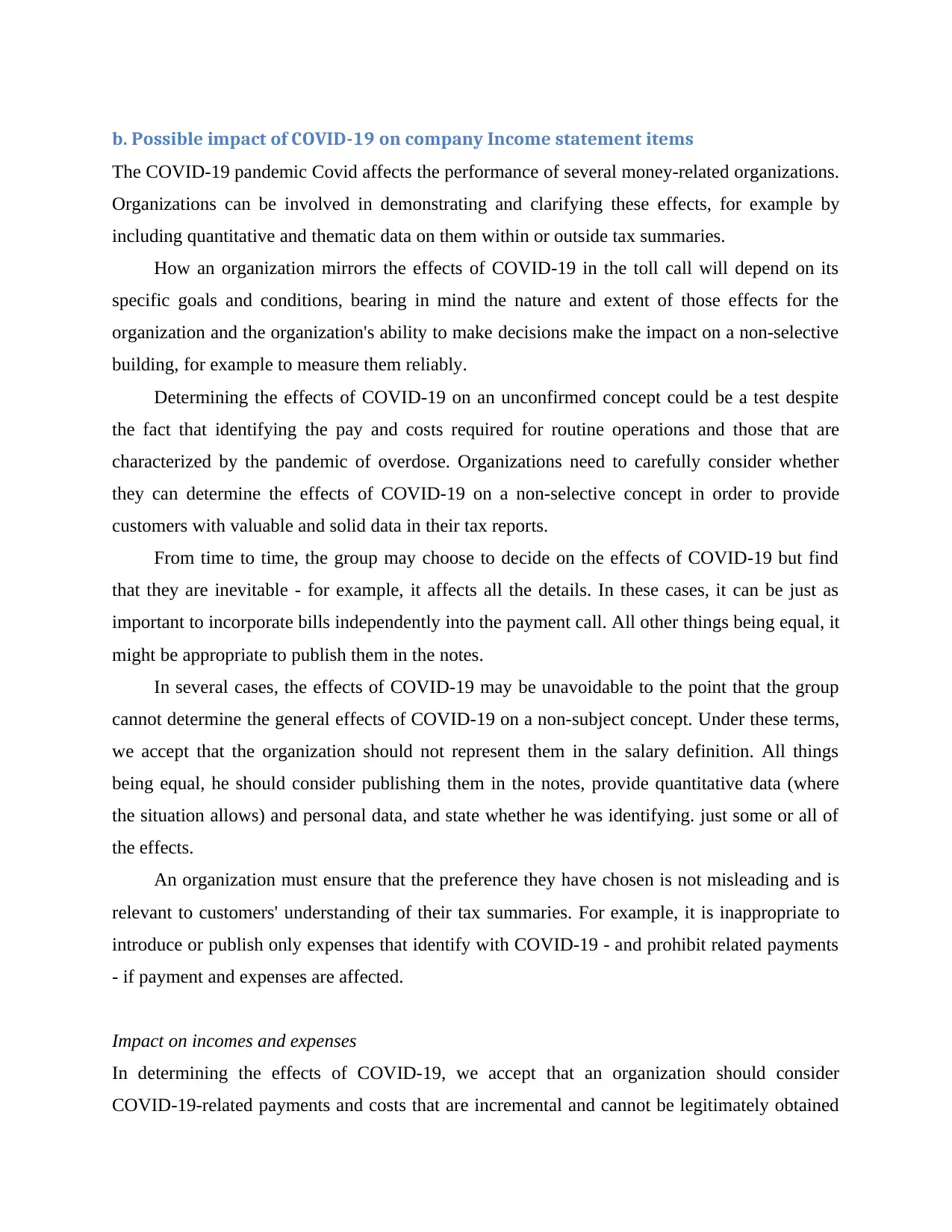
b. Possible impact of COVID-19 on company Income statement items
The COVID-19 pandemic Covid affects the performance of several money-related organizations.
Organizations can be involved in demonstrating and clarifying these effects, for example by
including quantitative and thematic data on them within or outside tax summaries.
How an organization mirrors the effects of COVID-19 in the toll call will depend on its
specific goals and conditions, bearing in mind the nature and extent of those effects for the
organization and the organization's ability to make decisions make the impact on a non-selective
building, for example to measure them reliably.
Determining the effects of COVID-19 on an unconfirmed concept could be a test despite
the fact that identifying the pay and costs required for routine operations and those that are
characterized by the pandemic of overdose. Organizations need to carefully consider whether
they can determine the effects of COVID-19 on a non-selective concept in order to provide
customers with valuable and solid data in their tax reports.
From time to time, the group may choose to decide on the effects of COVID-19 but find
that they are inevitable - for example, it affects all the details. In these cases, it can be just as
important to incorporate bills independently into the payment call. All other things being equal, it
might be appropriate to publish them in the notes.
In several cases, the effects of COVID-19 may be unavoidable to the point that the group
cannot determine the general effects of COVID-19 on a non-subject concept. Under these terms,
we accept that the organization should not represent them in the salary definition. All things
being equal, he should consider publishing them in the notes, provide quantitative data (where
the situation allows) and personal data, and state whether he was identifying. just some or all of
the effects.
An organization must ensure that the preference they have chosen is not misleading and is
relevant to customers' understanding of their tax summaries. For example, it is inappropriate to
introduce or publish only expenses that identify with COVID-19 - and prohibit related payments
- if payment and expenses are affected.
Impact on incomes and expenses
In determining the effects of COVID-19, we accept that an organization should consider
COVID-19-related payments and costs that are incremental and cannot be legitimately obtained
The COVID-19 pandemic Covid affects the performance of several money-related organizations.
Organizations can be involved in demonstrating and clarifying these effects, for example by
including quantitative and thematic data on them within or outside tax summaries.
How an organization mirrors the effects of COVID-19 in the toll call will depend on its
specific goals and conditions, bearing in mind the nature and extent of those effects for the
organization and the organization's ability to make decisions make the impact on a non-selective
building, for example to measure them reliably.
Determining the effects of COVID-19 on an unconfirmed concept could be a test despite
the fact that identifying the pay and costs required for routine operations and those that are
characterized by the pandemic of overdose. Organizations need to carefully consider whether
they can determine the effects of COVID-19 on a non-selective concept in order to provide
customers with valuable and solid data in their tax reports.
From time to time, the group may choose to decide on the effects of COVID-19 but find
that they are inevitable - for example, it affects all the details. In these cases, it can be just as
important to incorporate bills independently into the payment call. All other things being equal, it
might be appropriate to publish them in the notes.
In several cases, the effects of COVID-19 may be unavoidable to the point that the group
cannot determine the general effects of COVID-19 on a non-subject concept. Under these terms,
we accept that the organization should not represent them in the salary definition. All things
being equal, he should consider publishing them in the notes, provide quantitative data (where
the situation allows) and personal data, and state whether he was identifying. just some or all of
the effects.
An organization must ensure that the preference they have chosen is not misleading and is
relevant to customers' understanding of their tax summaries. For example, it is inappropriate to
introduce or publish only expenses that identify with COVID-19 - and prohibit related payments
- if payment and expenses are affected.
Impact on incomes and expenses
In determining the effects of COVID-19, we accept that an organization should consider
COVID-19-related payments and costs that are incremental and cannot be legitimately obtained
Paraphrase This Document
Need a fresh take? Get an instant paraphrase of this document with our AI Paraphraser
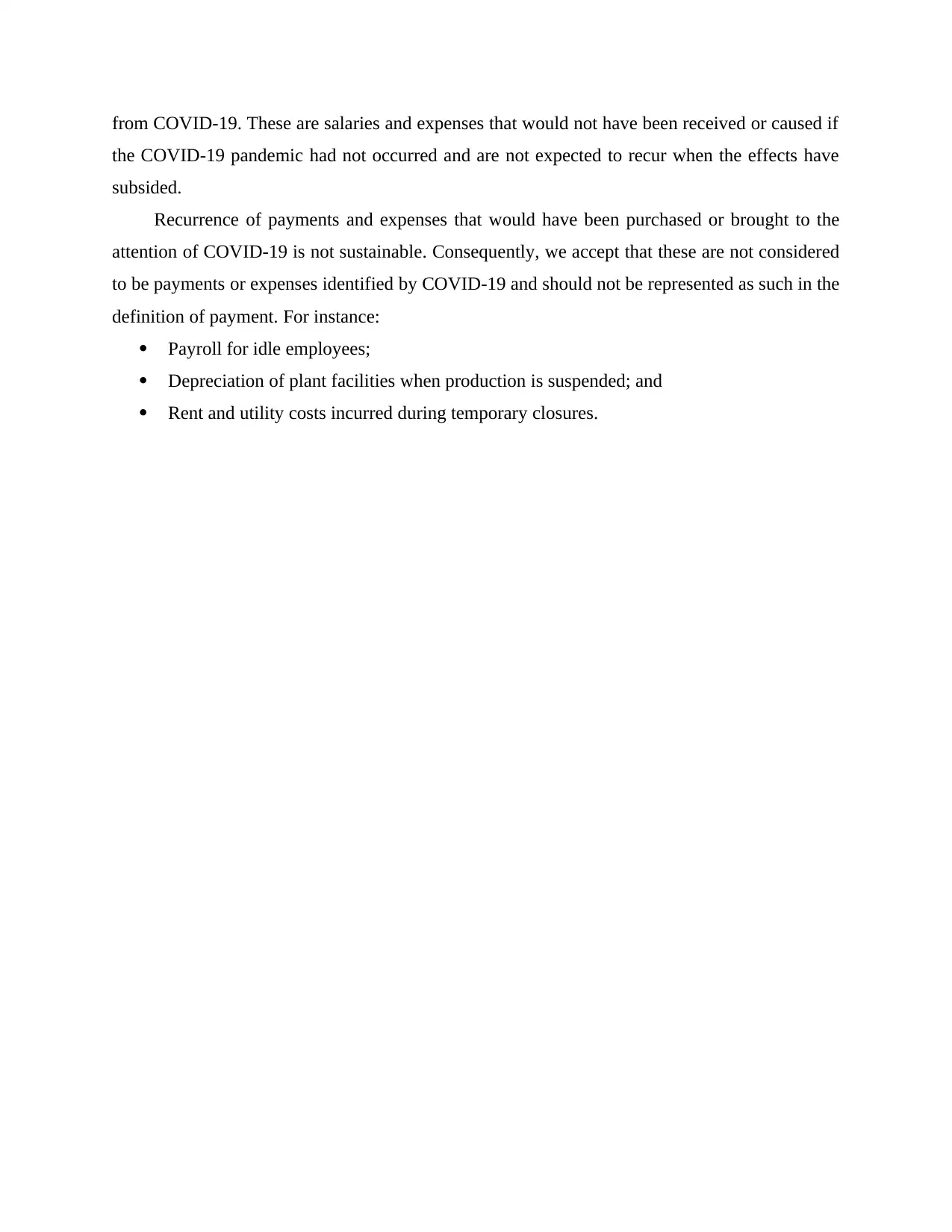
from COVID-19. These are salaries and expenses that would not have been received or caused if
the COVID-19 pandemic had not occurred and are not expected to recur when the effects have
subsided.
Recurrence of payments and expenses that would have been purchased or brought to the
attention of COVID-19 is not sustainable. Consequently, we accept that these are not considered
to be payments or expenses identified by COVID-19 and should not be represented as such in the
definition of payment. For instance:
Payroll for idle employees;
Depreciation of plant facilities when production is suspended; and
Rent and utility costs incurred during temporary closures.
the COVID-19 pandemic had not occurred and are not expected to recur when the effects have
subsided.
Recurrence of payments and expenses that would have been purchased or brought to the
attention of COVID-19 is not sustainable. Consequently, we accept that these are not considered
to be payments or expenses identified by COVID-19 and should not be represented as such in the
definition of payment. For instance:
Payroll for idle employees;
Depreciation of plant facilities when production is suspended; and
Rent and utility costs incurred during temporary closures.
1 out of 8
Related Documents
Your All-in-One AI-Powered Toolkit for Academic Success.
+13062052269
info@desklib.com
Available 24*7 on WhatsApp / Email
![[object Object]](/_next/static/media/star-bottom.7253800d.svg)
Unlock your academic potential
Copyright © 2020–2025 A2Z Services. All Rights Reserved. Developed and managed by ZUCOL.





